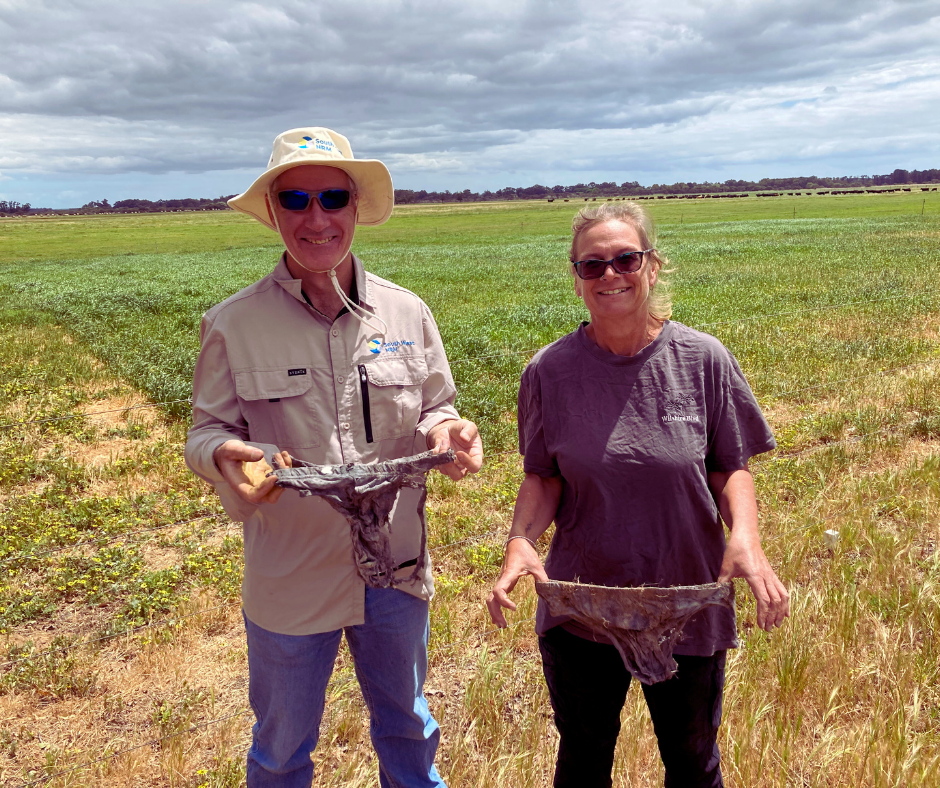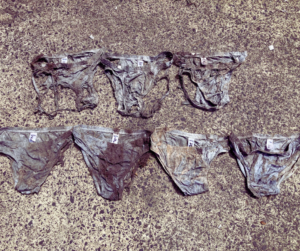

South West NRM Program Manager Sustainable Agriculture Peter Clifton and Kalgup host farmer Annette Battley from check out evidence of microbial activity on the buried undies.
What could burying 7 pairs of cotton undies in a Busselton paddock for 11 weeks tell the environmental experts at South West NRM about soil health?
The experiment might sound a tad quirky but the idea was based on a citizen science trend developed by a Queensland university which has swept through farms across Australia over the past couple of years.
South West NRM Program Manager Sustainable Agriculture Peter Clifton said the more holes in the undies after eight weeks, the healthier the soil.
Wondering how holey undies equates to healthy soil?
According to the University of Queensland who came up with the experiment in 2021 after seeing a similar one undertaken in Canada, measuring the amount of degradation in cotton buried for at least eight weeks provides a visual representation of activity levels by microscopic living organisms (or microbes) in the soil.
The more activity, or cotton eaten by the microbes, the healthier the soil.
Peter said it might not always be visible to the naked eye, but soil was teeming with life.
“Did you know there are more of these tiny microbes in one teaspoon of soil than there are people on earth?” he said.
“Keeping this microscopic soil community happy and healthy is an important focus for farmers who understand optimal soil health will ensure best possible outcomes for the size and quality of crops they can produce.”
As well as conservation work, South West NRM works to future-proof farming by driving innovation in the sector through adoption of economically viable sustainable technology and practices.
Through this work, Peter has been working with farmers to test the effect of various soil treatments on pasture growth and soil health.
Measuring soil health is notoriously difficult. The ‘Soil Your Undies’ challenge is a simple way to get some indication of microbial activity in each treatment, which converts organic matter into plant-available nutrients.
Five different treatments were used in three separate plots each, creating a total of 15 plots – with a pair of undies buried in each.
The undies were dug up in late October and Peter said the results were quite mixed from barely touched to some with gaping holes. 
And surprisingly, the variations existed even within the same soil treatments.
“What we have shown is that there is probably a lot of variation and ‘error’ in the result, so for more conclusive evidence we would need to a lot more replication,” Peter said.
“In other words, at least three pairs of undies buried in each treatment plot, which would be 45 pairs in total!”
“If nothing else, this is a good example of why we use at least some basic science to inform our knowledge and have confidence in results.
“Replication increases confidence in results, but it’s not the only factor. We should also use accepted scientific monitoring techniques, of which, burying undies certainly isn’t one, but it’s a lot cheaper and a lot more fun!”
For further reading, you can read our Case Study: Selecting & testing biological amendments by clicking the below button.
